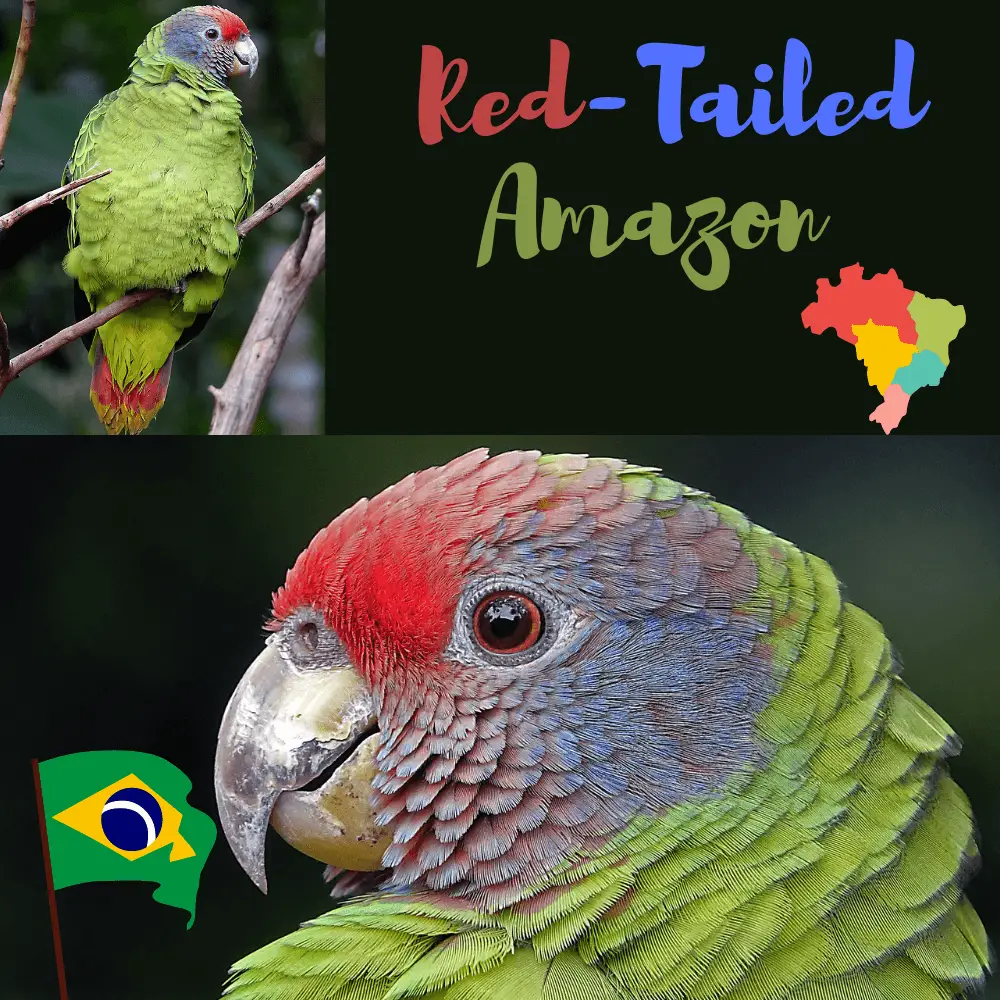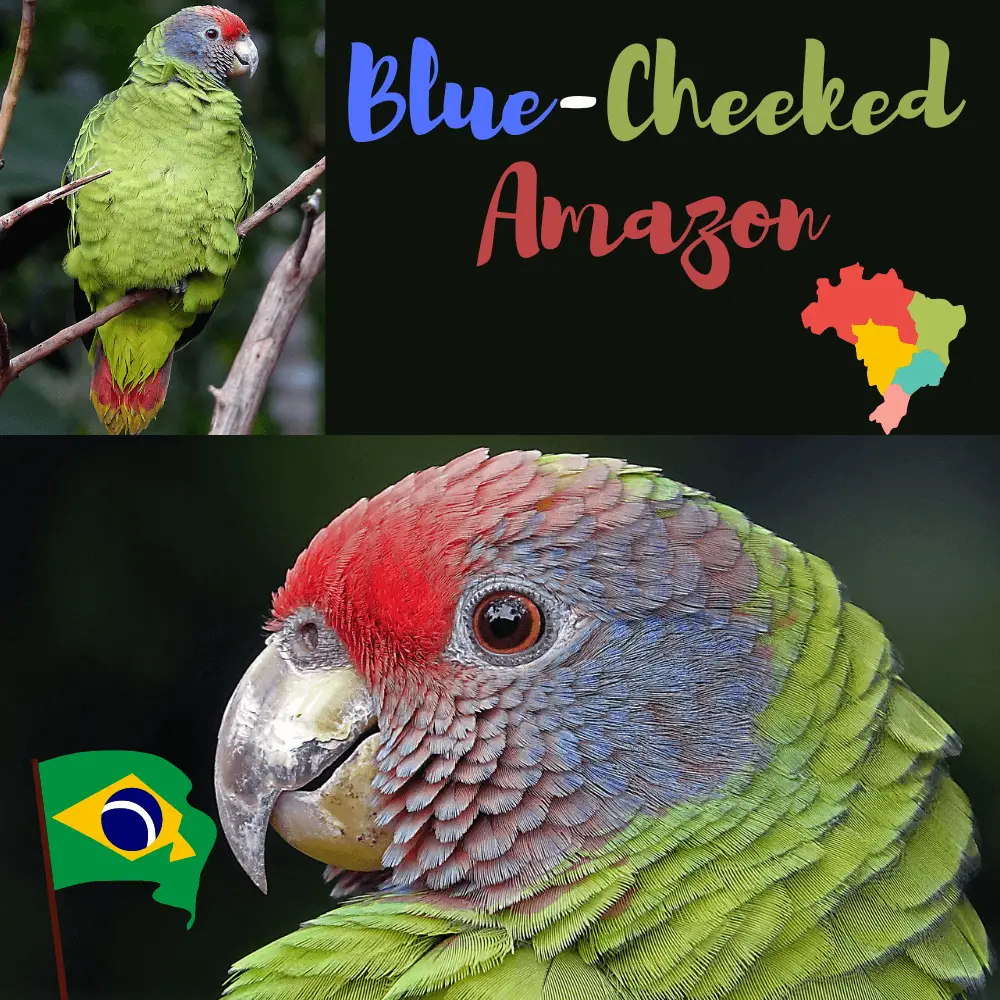
The Red-tailed Amazon or Blue-cheeked Amazon (Amazona brasiliensis) is an Amazon Parrot species of bird in the Psittacidae family.
| Reign | Animal |
|---|---|
| Fork | Chordata |
| Class | Poultry |
| Order | Psittaciformes |
| Family | Psittacidae |
| Gender | Amazon |
Description
It is a large species for the genus Amazona since it measures about 37 cm.
It has a dark green base coloration, a little lighter on the lower parts. The forehead is red, and coloration washing on the neck. The cheeks are purple-tinged with azure blue, a brighter color in the peri-ear regions. This purple coloration tends towards pink at the chin. The essentially green wings are bordered with yellow, the secondary remiges are purple-blue at their ends while the primaries are black. The rectrices are red with a yellow tip. The irises are brown. The eyes have a slight, very clear orbital circle.
Distribution
This bird is found only in a small area (about 2,000 km2) in southeastern Brazil, from southeastern Sao Paulo in Parana to the Rio Grande in the south. Its numbers increased from about 4,500 in the 1980s to 2,000 in 1991 and 1992. These seem to have improved and exceeded 5,000 in 2004. and then reaches 6,600.
A 2014 count reported 7,452.
In this large Amazon, the forehead, the front of the hood, and the lores are red, the feathers located furthest back on the cap having purplish tips. The cheeks, ear covers, sides of the neck, and throat form a blue-purple ensemble. The feathers of the back of the cap and neck are green with black ends.
The upper parts are green, with some rump feathers slightly tinged with yellow. The large covers, the medium covers as well as part of the secondary ones are strongly bordered with yellow. The leading edge of the wings is red and yellow. The primaries are grayish-black, the secondaries green with a blue edge.
The underside of the wings is yellowish-green on the covers and blackish on the remiges. The lower parts are entirely yellowish-green. The subcaudals display a paler green. The tail is green with wide yellowish tips. The lateral rectrices are blue-violet at the base, marked by a wide red stripe in their middle part and ending with a yellowish-green tip. The beak is a pale horn with a black tip. The irises are orange. The legs and feet have a pinkish-gray color.
Voice
In-flight, the blue-cheeked Amazon emits “kraaaa kraaaa” somewhat similar to a crow croaking. In other circumstances, it produces “kli kli” and “krayo” quite identical to those of blue-fronted amazons (Amazona aestiva).
Habitat
This species is confined to a thin coastal strip formed by lowland forests and wetlands. This region, which has a rather complex structure, includes both wet woodlands, freshwater marshes, mangroves, and resting (sandy and salty soils, close to the sea, and covered with characteristic herbaceous plants). Its favorite habitats usually include a fairly inextricable network of canals, wetlands, and swamps. The trees that make up the forests are typical of the genus Luehea or Andira. The vegetation that dominates in small islands is formed by halophyte plants (able to adapt to salty soils). Many blue-cheeked Amazons are sedentary in flooded forests, probably because they provide a large selection of nesting sites. Although they have been spotted up to 700 m in the Paranà, these birds do not usually climb above 300 or 400 meters above sea level.

Character trait behavior
The Blue-cheeked Amazon often forms common dormitories in mangroves, at least at certain times of the year. There is a report from 1985 that shows a group of more than 750 individuals. Nevertheless, most of the time, this bird seeks its food in pairs or small bands with a maximum of twenty elements. The Blue-cheeked Amazon is mostly sedentary. There may be some local migratory movements during the winter period (May-August), with some birds heading inland for sustenance.
Diet and diet
Blue-cheeked Amazons have a vegetarian or frugivorous diet. It seems that the fruits of a local Clusiaceae (Calophyllum Brasiliense) represent a primordial part of its diet. The fruits of some trees of the genus Syagrus and Psidium are also taken in quantity. Red flowers and fruits of erythrina often complete the menu. A few insects are rarely caught.
Nesting reproduction
Blue-cheeked Amazons nest in the cavities of dead or healthy trees. The trees that serve as their pantry are also those that serve them for nesting. Tree termite mounds are also sometimes used. The nest is usually placed at a great height, but it can be located as low as a meter when it overlooks a body of water.
Most of the time, Amazons choose flooded forests or mangroves to establish their nests. The breeding season runs from September to February, sometimes extending into April. The female lays 3 or 4 eggs that are incubated for about 27 or 28 days. The young leave the nest after 50 to 55 days or 7 to 8 weeks.
Distribution
The Blue-cheeked Amazon is endemic to southeastern Brazil, in the states of Sao Paulo and Paranà. It occupies a stretch of coastline that runs from Itanhaem to Paranagua Bay and a little further south to Garatuba. This bird is probably also present in the extreme northeast of Santa Catarina and the Rio Grande do Sul, although there are no reports from these 2 states. Given the small size of its range, the species has no geographical variations and is considered monotypic.
Threats – Protection
In the 70s, the species quickly decreased, from 4500 individuals to nearly 2000. It seems that currently, the population has risen to around 4500 to 5000 birds. Two main dangers threaten this species. The first of these is the loss or deterioration of its habitat.
Natural wetland habitats are being converted into breeding grounds for livestock and water buffaloes. Palm trees and mangroves are regularly cut or deteriorated to meet the requirements of tourism which are highly developed in this region. The second threat is poaching. Since the blue-cheeked Amazon is a very popular pet bird, the young are taken directly from the nest where they are easy prey.
In 1991 and 1992 alone, more than 350 Amazons were illegally traded. “Scouts” often damage cavities when they take hold of their victims, which further increases the damage at the expense of this species and significantly reduces the number of nesting sites. For the reasons set out above, the IUCN has classified the species as Vulnerable.
A blue cheeked amazon (Amazona dufresniana) at Loro Parque Fundacion
SOURCE:Video Ark
Related Articles:




















